Manual Handling and Fall Prevention in Nursing Practice: A Report
VerifiedAdded on 2023/06/05
|11
|3184
|147
Report
AI Summary
This report delves into the critical challenges faced by nurses, particularly concerning manual handling of mobility-restricted patients and fall prevention. It highlights the significant risks associated with manual handling, including musculoskeletal injuries for nurses and increased fall risks for patients, especially in acute and aged care settings. The report analyzes the impact of these challenges on workplace stress and burnout among nurses. It examines existing policies and identifies a need for improved training, skill enhancement, and supportive interventions. Recommendations include evidence-based training, patient-specific handling techniques, and the integration of patient-handling devices to reduce injury and fall rates. The report emphasizes the importance of a compassionate approach for nurses and the need for policies that prioritize nurse well-being and patient safety to create a safer and more supportive healthcare environment.
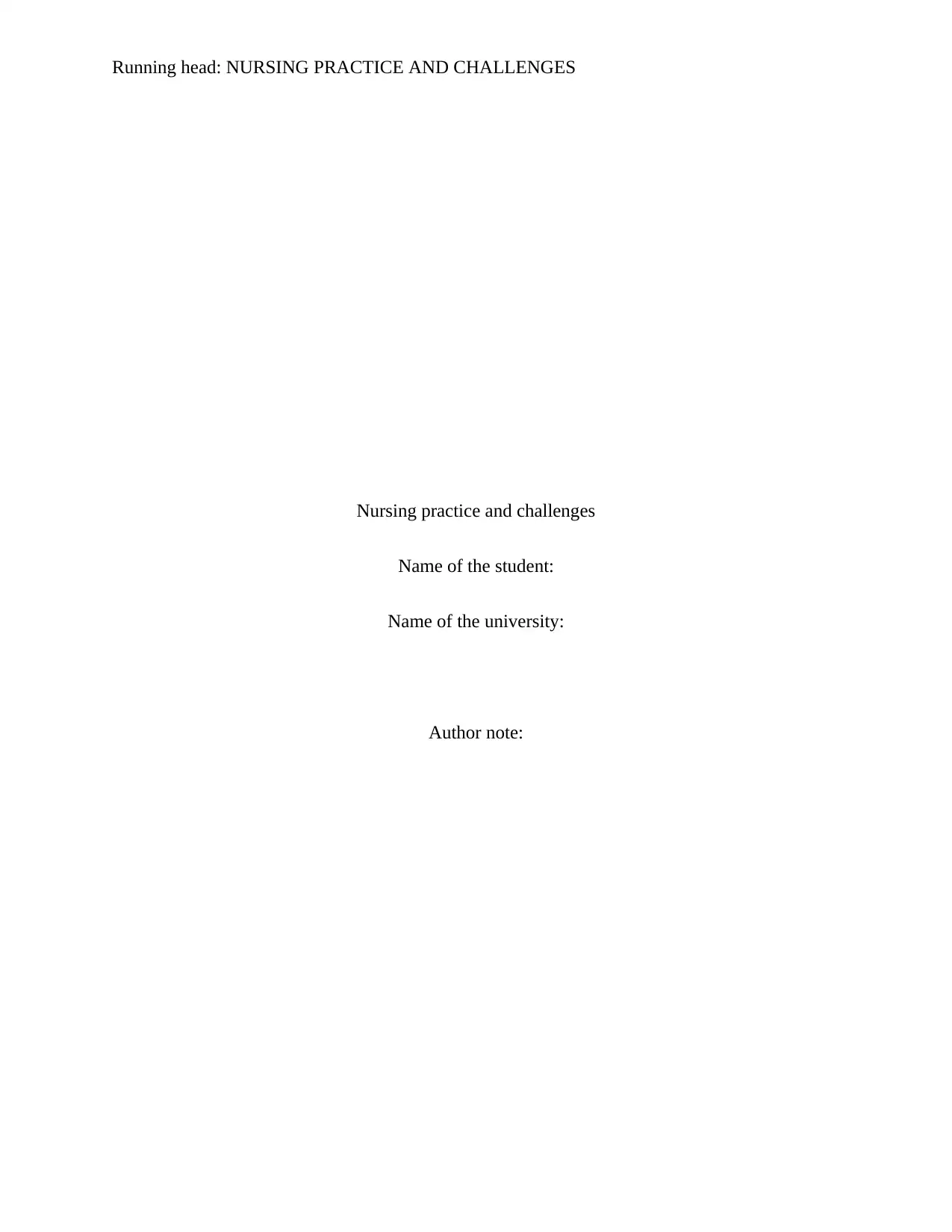
Running head: NURSING PRACTICE AND CHALLENGES
Nursing practice and challenges
Name of the student:
Name of the university:
Author note:
Nursing practice and challenges
Name of the student:
Name of the university:
Author note:
Paraphrase This Document
Need a fresh take? Get an instant paraphrase of this document with our AI Paraphraser
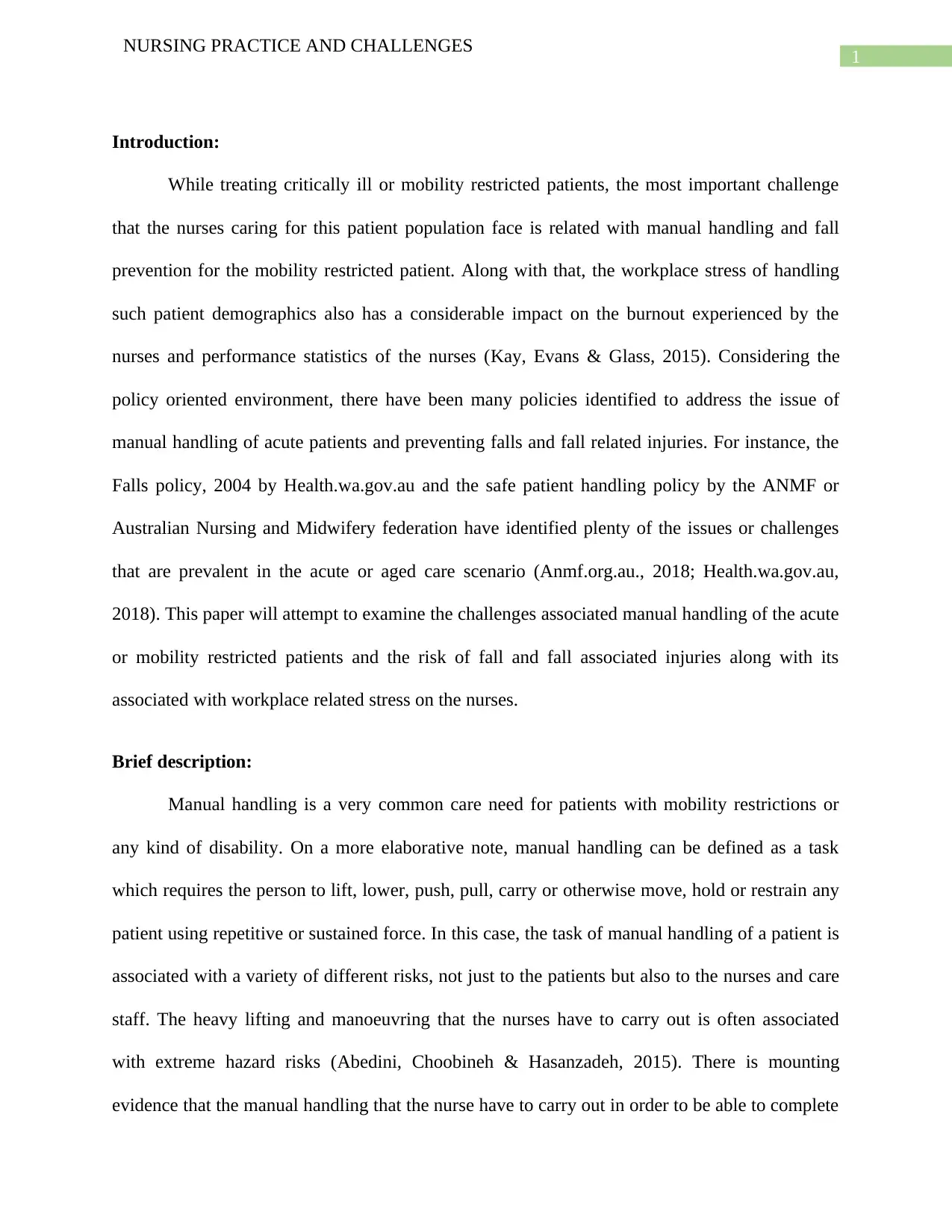
1
NURSING PRACTICE AND CHALLENGES
Introduction:
While treating critically ill or mobility restricted patients, the most important challenge
that the nurses caring for this patient population face is related with manual handling and fall
prevention for the mobility restricted patient. Along with that, the workplace stress of handling
such patient demographics also has a considerable impact on the burnout experienced by the
nurses and performance statistics of the nurses (Kay, Evans & Glass, 2015). Considering the
policy oriented environment, there have been many policies identified to address the issue of
manual handling of acute patients and preventing falls and fall related injuries. For instance, the
Falls policy, 2004 by Health.wa.gov.au and the safe patient handling policy by the ANMF or
Australian Nursing and Midwifery federation have identified plenty of the issues or challenges
that are prevalent in the acute or aged care scenario (Anmf.org.au., 2018; Health.wa.gov.au,
2018). This paper will attempt to examine the challenges associated manual handling of the acute
or mobility restricted patients and the risk of fall and fall associated injuries along with its
associated with workplace related stress on the nurses.
Brief description:
Manual handling is a very common care need for patients with mobility restrictions or
any kind of disability. On a more elaborative note, manual handling can be defined as a task
which requires the person to lift, lower, push, pull, carry or otherwise move, hold or restrain any
patient using repetitive or sustained force. In this case, the task of manual handling of a patient is
associated with a variety of different risks, not just to the patients but also to the nurses and care
staff. The heavy lifting and manoeuvring that the nurses have to carry out is often associated
with extreme hazard risks (Abedini, Choobineh & Hasanzadeh, 2015). There is mounting
evidence that the manual handling that the nurse have to carry out in order to be able to complete
NURSING PRACTICE AND CHALLENGES
Introduction:
While treating critically ill or mobility restricted patients, the most important challenge
that the nurses caring for this patient population face is related with manual handling and fall
prevention for the mobility restricted patient. Along with that, the workplace stress of handling
such patient demographics also has a considerable impact on the burnout experienced by the
nurses and performance statistics of the nurses (Kay, Evans & Glass, 2015). Considering the
policy oriented environment, there have been many policies identified to address the issue of
manual handling of acute patients and preventing falls and fall related injuries. For instance, the
Falls policy, 2004 by Health.wa.gov.au and the safe patient handling policy by the ANMF or
Australian Nursing and Midwifery federation have identified plenty of the issues or challenges
that are prevalent in the acute or aged care scenario (Anmf.org.au., 2018; Health.wa.gov.au,
2018). This paper will attempt to examine the challenges associated manual handling of the acute
or mobility restricted patients and the risk of fall and fall associated injuries along with its
associated with workplace related stress on the nurses.
Brief description:
Manual handling is a very common care need for patients with mobility restrictions or
any kind of disability. On a more elaborative note, manual handling can be defined as a task
which requires the person to lift, lower, push, pull, carry or otherwise move, hold or restrain any
patient using repetitive or sustained force. In this case, the task of manual handling of a patient is
associated with a variety of different risks, not just to the patients but also to the nurses and care
staff. The heavy lifting and manoeuvring that the nurses have to carry out is often associated
with extreme hazard risks (Abedini, Choobineh & Hasanzadeh, 2015). There is mounting
evidence that the manual handling that the nurse have to carry out in order to be able to complete
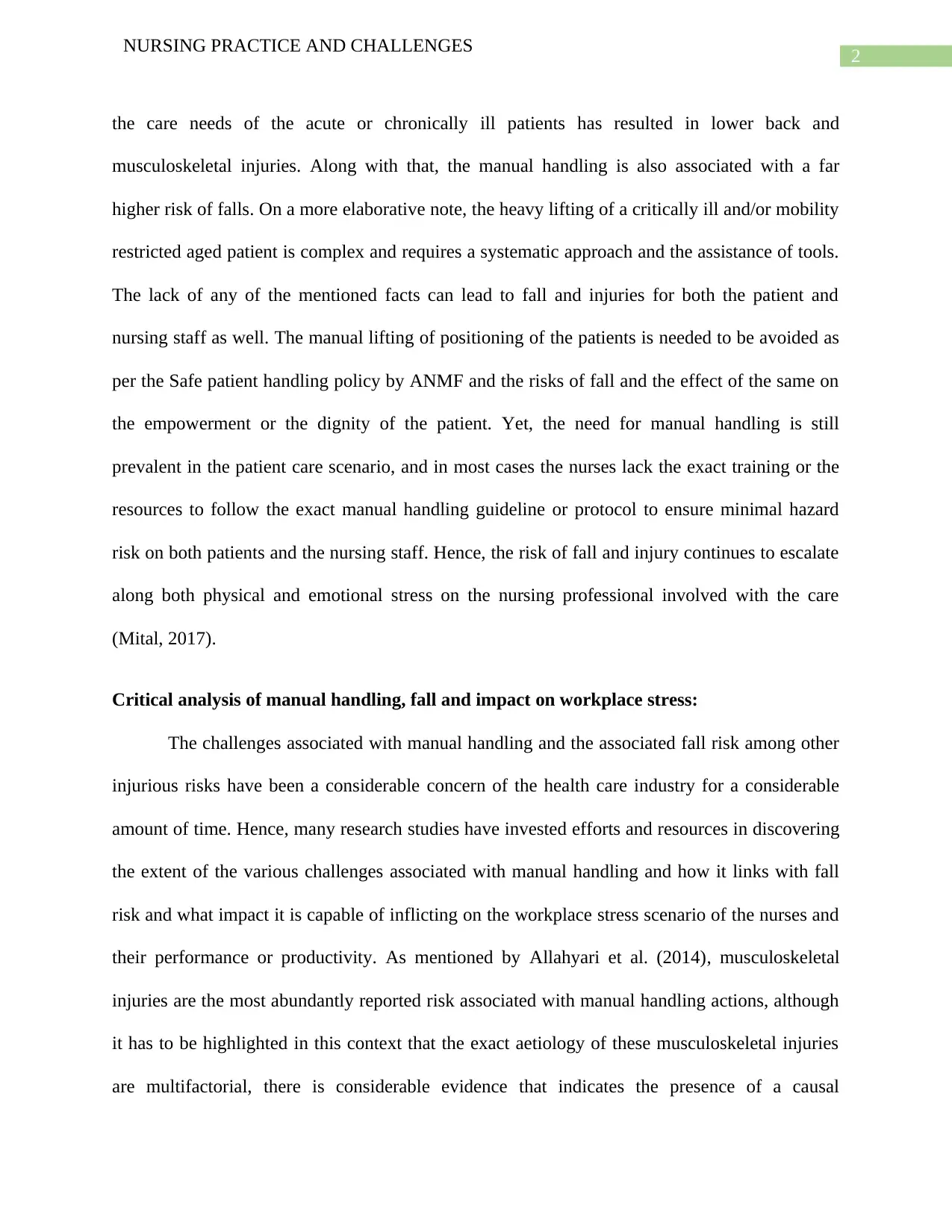
2
NURSING PRACTICE AND CHALLENGES
the care needs of the acute or chronically ill patients has resulted in lower back and
musculoskeletal injuries. Along with that, the manual handling is also associated with a far
higher risk of falls. On a more elaborative note, the heavy lifting of a critically ill and/or mobility
restricted aged patient is complex and requires a systematic approach and the assistance of tools.
The lack of any of the mentioned facts can lead to fall and injuries for both the patient and
nursing staff as well. The manual lifting of positioning of the patients is needed to be avoided as
per the Safe patient handling policy by ANMF and the risks of fall and the effect of the same on
the empowerment or the dignity of the patient. Yet, the need for manual handling is still
prevalent in the patient care scenario, and in most cases the nurses lack the exact training or the
resources to follow the exact manual handling guideline or protocol to ensure minimal hazard
risk on both patients and the nursing staff. Hence, the risk of fall and injury continues to escalate
along both physical and emotional stress on the nursing professional involved with the care
(Mital, 2017).
Critical analysis of manual handling, fall and impact on workplace stress:
The challenges associated with manual handling and the associated fall risk among other
injurious risks have been a considerable concern of the health care industry for a considerable
amount of time. Hence, many research studies have invested efforts and resources in discovering
the extent of the various challenges associated with manual handling and how it links with fall
risk and what impact it is capable of inflicting on the workplace stress scenario of the nurses and
their performance or productivity. As mentioned by Allahyari et al. (2014), musculoskeletal
injuries are the most abundantly reported risk associated with manual handling actions, although
it has to be highlighted in this context that the exact aetiology of these musculoskeletal injuries
are multifactorial, there is considerable evidence that indicates the presence of a causal
NURSING PRACTICE AND CHALLENGES
the care needs of the acute or chronically ill patients has resulted in lower back and
musculoskeletal injuries. Along with that, the manual handling is also associated with a far
higher risk of falls. On a more elaborative note, the heavy lifting of a critically ill and/or mobility
restricted aged patient is complex and requires a systematic approach and the assistance of tools.
The lack of any of the mentioned facts can lead to fall and injuries for both the patient and
nursing staff as well. The manual lifting of positioning of the patients is needed to be avoided as
per the Safe patient handling policy by ANMF and the risks of fall and the effect of the same on
the empowerment or the dignity of the patient. Yet, the need for manual handling is still
prevalent in the patient care scenario, and in most cases the nurses lack the exact training or the
resources to follow the exact manual handling guideline or protocol to ensure minimal hazard
risk on both patients and the nursing staff. Hence, the risk of fall and injury continues to escalate
along both physical and emotional stress on the nursing professional involved with the care
(Mital, 2017).
Critical analysis of manual handling, fall and impact on workplace stress:
The challenges associated with manual handling and the associated fall risk among other
injurious risks have been a considerable concern of the health care industry for a considerable
amount of time. Hence, many research studies have invested efforts and resources in discovering
the extent of the various challenges associated with manual handling and how it links with fall
risk and what impact it is capable of inflicting on the workplace stress scenario of the nurses and
their performance or productivity. As mentioned by Allahyari et al. (2014), musculoskeletal
injuries are the most abundantly reported risk associated with manual handling actions, although
it has to be highlighted in this context that the exact aetiology of these musculoskeletal injuries
are multifactorial, there is considerable evidence that indicates the presence of a causal
⊘ This is a preview!⊘
Do you want full access?
Subscribe today to unlock all pages.

Trusted by 1+ million students worldwide
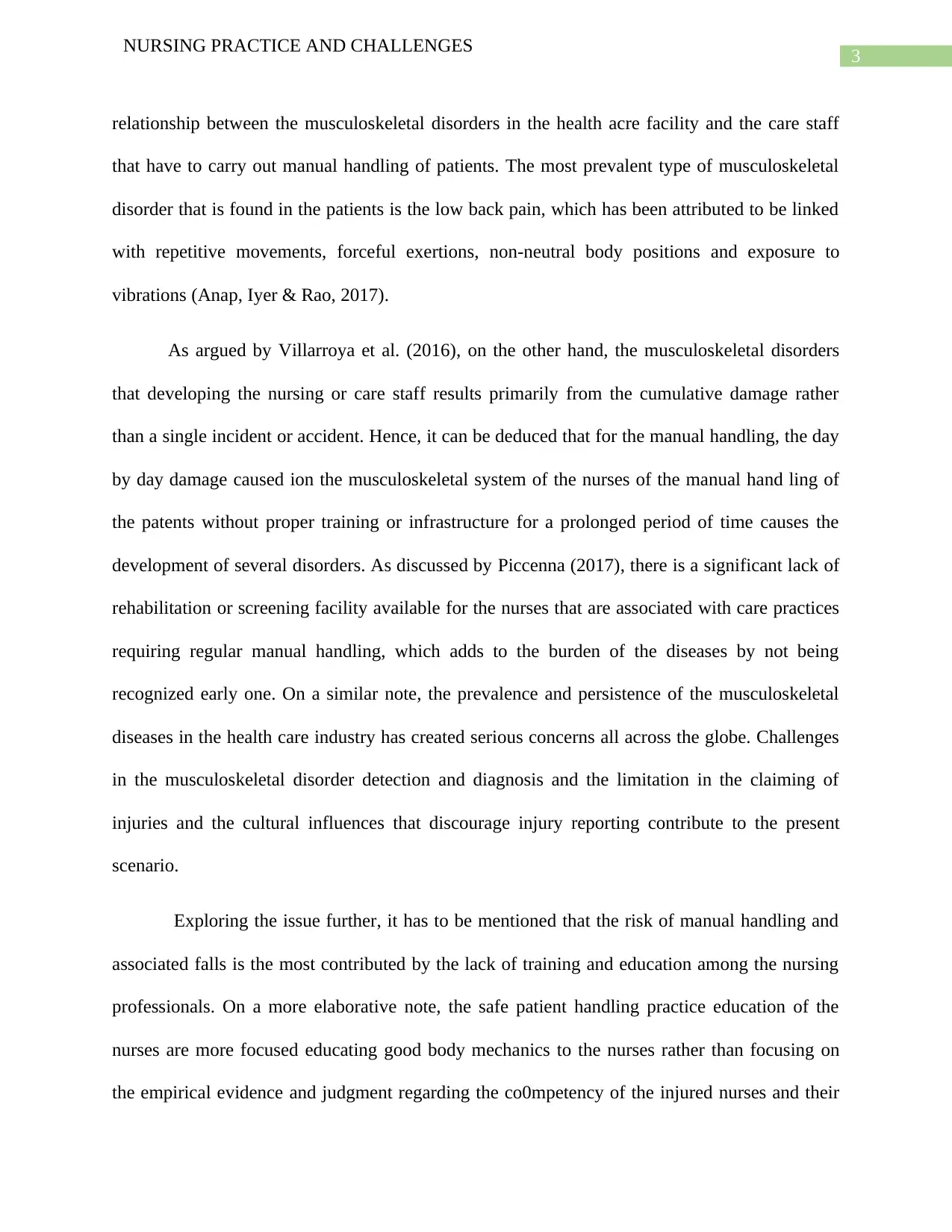
3
NURSING PRACTICE AND CHALLENGES
relationship between the musculoskeletal disorders in the health acre facility and the care staff
that have to carry out manual handling of patients. The most prevalent type of musculoskeletal
disorder that is found in the patients is the low back pain, which has been attributed to be linked
with repetitive movements, forceful exertions, non-neutral body positions and exposure to
vibrations (Anap, Iyer & Rao, 2017).
As argued by Villarroya et al. (2016), on the other hand, the musculoskeletal disorders
that developing the nursing or care staff results primarily from the cumulative damage rather
than a single incident or accident. Hence, it can be deduced that for the manual handling, the day
by day damage caused ion the musculoskeletal system of the nurses of the manual hand ling of
the patents without proper training or infrastructure for a prolonged period of time causes the
development of several disorders. As discussed by Piccenna (2017), there is a significant lack of
rehabilitation or screening facility available for the nurses that are associated with care practices
requiring regular manual handling, which adds to the burden of the diseases by not being
recognized early one. On a similar note, the prevalence and persistence of the musculoskeletal
diseases in the health care industry has created serious concerns all across the globe. Challenges
in the musculoskeletal disorder detection and diagnosis and the limitation in the claiming of
injuries and the cultural influences that discourage injury reporting contribute to the present
scenario.
Exploring the issue further, it has to be mentioned that the risk of manual handling and
associated falls is the most contributed by the lack of training and education among the nursing
professionals. On a more elaborative note, the safe patient handling practice education of the
nurses are more focused educating good body mechanics to the nurses rather than focusing on
the empirical evidence and judgment regarding the co0mpetency of the injured nurses and their
NURSING PRACTICE AND CHALLENGES
relationship between the musculoskeletal disorders in the health acre facility and the care staff
that have to carry out manual handling of patients. The most prevalent type of musculoskeletal
disorder that is found in the patients is the low back pain, which has been attributed to be linked
with repetitive movements, forceful exertions, non-neutral body positions and exposure to
vibrations (Anap, Iyer & Rao, 2017).
As argued by Villarroya et al. (2016), on the other hand, the musculoskeletal disorders
that developing the nursing or care staff results primarily from the cumulative damage rather
than a single incident or accident. Hence, it can be deduced that for the manual handling, the day
by day damage caused ion the musculoskeletal system of the nurses of the manual hand ling of
the patents without proper training or infrastructure for a prolonged period of time causes the
development of several disorders. As discussed by Piccenna (2017), there is a significant lack of
rehabilitation or screening facility available for the nurses that are associated with care practices
requiring regular manual handling, which adds to the burden of the diseases by not being
recognized early one. On a similar note, the prevalence and persistence of the musculoskeletal
diseases in the health care industry has created serious concerns all across the globe. Challenges
in the musculoskeletal disorder detection and diagnosis and the limitation in the claiming of
injuries and the cultural influences that discourage injury reporting contribute to the present
scenario.
Exploring the issue further, it has to be mentioned that the risk of manual handling and
associated falls is the most contributed by the lack of training and education among the nursing
professionals. On a more elaborative note, the safe patient handling practice education of the
nurses are more focused educating good body mechanics to the nurses rather than focusing on
the empirical evidence and judgment regarding the co0mpetency of the injured nurses and their
Paraphrase This Document
Need a fresh take? Get an instant paraphrase of this document with our AI Paraphraser
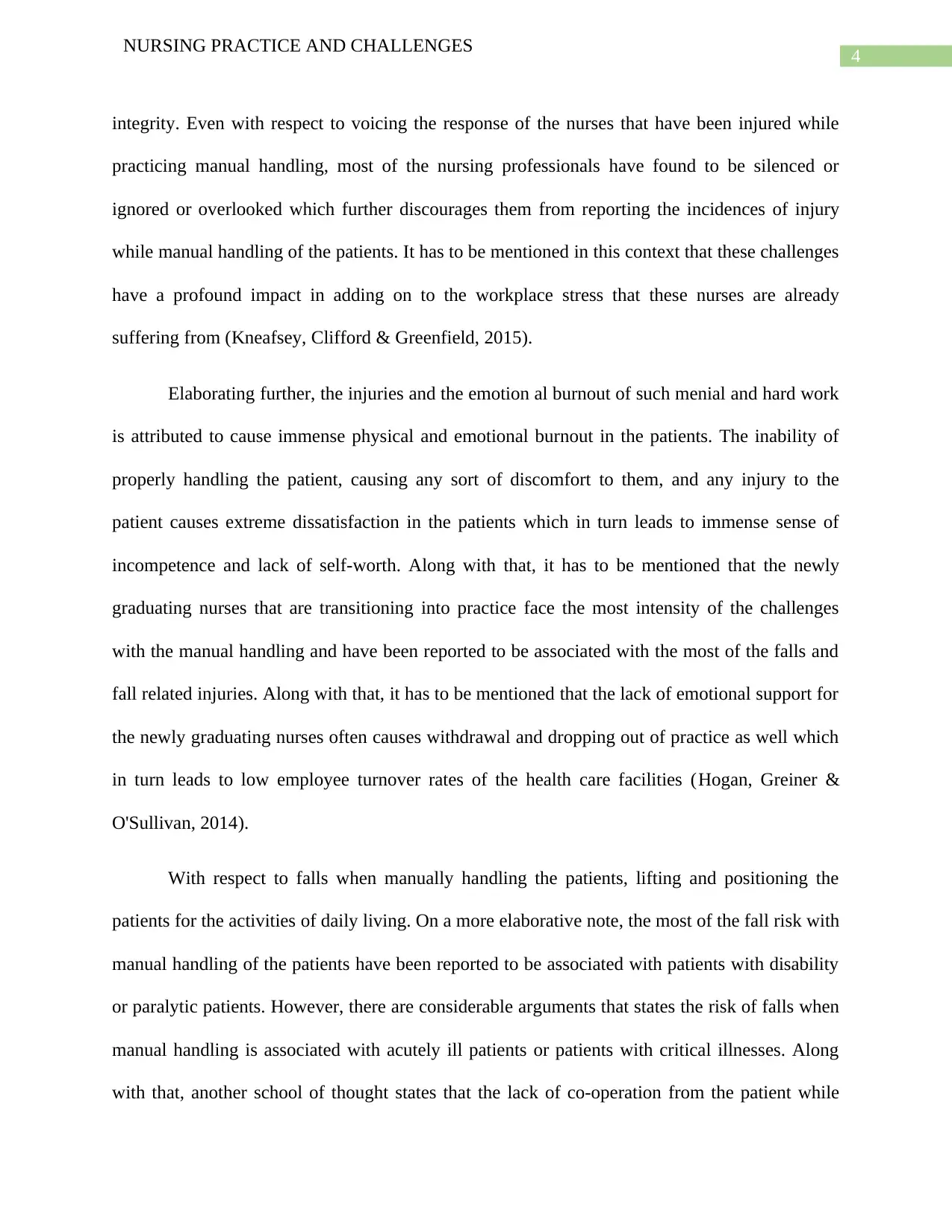
4
NURSING PRACTICE AND CHALLENGES
integrity. Even with respect to voicing the response of the nurses that have been injured while
practicing manual handling, most of the nursing professionals have found to be silenced or
ignored or overlooked which further discourages them from reporting the incidences of injury
while manual handling of the patients. It has to be mentioned in this context that these challenges
have a profound impact in adding on to the workplace stress that these nurses are already
suffering from (Kneafsey, Clifford & Greenfield, 2015).
Elaborating further, the injuries and the emotion al burnout of such menial and hard work
is attributed to cause immense physical and emotional burnout in the patients. The inability of
properly handling the patient, causing any sort of discomfort to them, and any injury to the
patient causes extreme dissatisfaction in the patients which in turn leads to immense sense of
incompetence and lack of self-worth. Along with that, it has to be mentioned that the newly
graduating nurses that are transitioning into practice face the most intensity of the challenges
with the manual handling and have been reported to be associated with the most of the falls and
fall related injuries. Along with that, it has to be mentioned that the lack of emotional support for
the newly graduating nurses often causes withdrawal and dropping out of practice as well which
in turn leads to low employee turnover rates of the health care facilities (Hogan, Greiner &
O'Sullivan, 2014).
With respect to falls when manually handling the patients, lifting and positioning the
patients for the activities of daily living. On a more elaborative note, the most of the fall risk with
manual handling of the patients have been reported to be associated with patients with disability
or paralytic patients. However, there are considerable arguments that states the risk of falls when
manual handling is associated with acutely ill patients or patients with critical illnesses. Along
with that, another school of thought states that the lack of co-operation from the patient while
NURSING PRACTICE AND CHALLENGES
integrity. Even with respect to voicing the response of the nurses that have been injured while
practicing manual handling, most of the nursing professionals have found to be silenced or
ignored or overlooked which further discourages them from reporting the incidences of injury
while manual handling of the patients. It has to be mentioned in this context that these challenges
have a profound impact in adding on to the workplace stress that these nurses are already
suffering from (Kneafsey, Clifford & Greenfield, 2015).
Elaborating further, the injuries and the emotion al burnout of such menial and hard work
is attributed to cause immense physical and emotional burnout in the patients. The inability of
properly handling the patient, causing any sort of discomfort to them, and any injury to the
patient causes extreme dissatisfaction in the patients which in turn leads to immense sense of
incompetence and lack of self-worth. Along with that, it has to be mentioned that the newly
graduating nurses that are transitioning into practice face the most intensity of the challenges
with the manual handling and have been reported to be associated with the most of the falls and
fall related injuries. Along with that, it has to be mentioned that the lack of emotional support for
the newly graduating nurses often causes withdrawal and dropping out of practice as well which
in turn leads to low employee turnover rates of the health care facilities (Hogan, Greiner &
O'Sullivan, 2014).
With respect to falls when manually handling the patients, lifting and positioning the
patients for the activities of daily living. On a more elaborative note, the most of the fall risk with
manual handling of the patients have been reported to be associated with patients with disability
or paralytic patients. However, there are considerable arguments that states the risk of falls when
manual handling is associated with acutely ill patients or patients with critical illnesses. Along
with that, another school of thought states that the lack of co-operation from the patient while
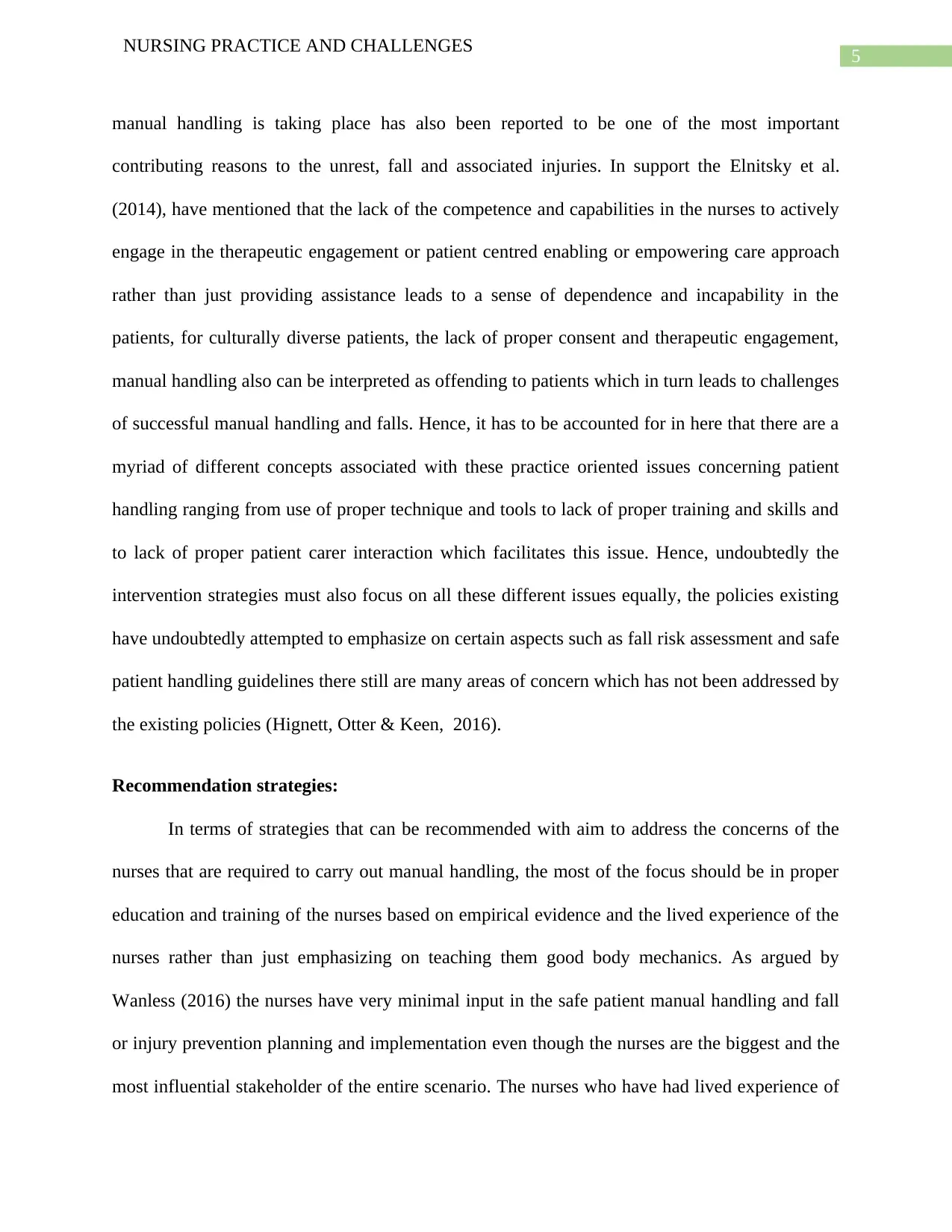
5
NURSING PRACTICE AND CHALLENGES
manual handling is taking place has also been reported to be one of the most important
contributing reasons to the unrest, fall and associated injuries. In support the Elnitsky et al.
(2014), have mentioned that the lack of the competence and capabilities in the nurses to actively
engage in the therapeutic engagement or patient centred enabling or empowering care approach
rather than just providing assistance leads to a sense of dependence and incapability in the
patients, for culturally diverse patients, the lack of proper consent and therapeutic engagement,
manual handling also can be interpreted as offending to patients which in turn leads to challenges
of successful manual handling and falls. Hence, it has to be accounted for in here that there are a
myriad of different concepts associated with these practice oriented issues concerning patient
handling ranging from use of proper technique and tools to lack of proper training and skills and
to lack of proper patient carer interaction which facilitates this issue. Hence, undoubtedly the
intervention strategies must also focus on all these different issues equally, the policies existing
have undoubtedly attempted to emphasize on certain aspects such as fall risk assessment and safe
patient handling guidelines there still are many areas of concern which has not been addressed by
the existing policies (Hignett, Otter & Keen, 2016).
Recommendation strategies:
In terms of strategies that can be recommended with aim to address the concerns of the
nurses that are required to carry out manual handling, the most of the focus should be in proper
education and training of the nurses based on empirical evidence and the lived experience of the
nurses rather than just emphasizing on teaching them good body mechanics. As argued by
Wanless (2016) the nurses have very minimal input in the safe patient manual handling and fall
or injury prevention planning and implementation even though the nurses are the biggest and the
most influential stakeholder of the entire scenario. The nurses who have had lived experience of
NURSING PRACTICE AND CHALLENGES
manual handling is taking place has also been reported to be one of the most important
contributing reasons to the unrest, fall and associated injuries. In support the Elnitsky et al.
(2014), have mentioned that the lack of the competence and capabilities in the nurses to actively
engage in the therapeutic engagement or patient centred enabling or empowering care approach
rather than just providing assistance leads to a sense of dependence and incapability in the
patients, for culturally diverse patients, the lack of proper consent and therapeutic engagement,
manual handling also can be interpreted as offending to patients which in turn leads to challenges
of successful manual handling and falls. Hence, it has to be accounted for in here that there are a
myriad of different concepts associated with these practice oriented issues concerning patient
handling ranging from use of proper technique and tools to lack of proper training and skills and
to lack of proper patient carer interaction which facilitates this issue. Hence, undoubtedly the
intervention strategies must also focus on all these different issues equally, the policies existing
have undoubtedly attempted to emphasize on certain aspects such as fall risk assessment and safe
patient handling guidelines there still are many areas of concern which has not been addressed by
the existing policies (Hignett, Otter & Keen, 2016).
Recommendation strategies:
In terms of strategies that can be recommended with aim to address the concerns of the
nurses that are required to carry out manual handling, the most of the focus should be in proper
education and training of the nurses based on empirical evidence and the lived experience of the
nurses rather than just emphasizing on teaching them good body mechanics. As argued by
Wanless (2016) the nurses have very minimal input in the safe patient manual handling and fall
or injury prevention planning and implementation even though the nurses are the biggest and the
most influential stakeholder of the entire scenario. The nurses who have had lived experience of
⊘ This is a preview!⊘
Do you want full access?
Subscribe today to unlock all pages.

Trusted by 1+ million students worldwide
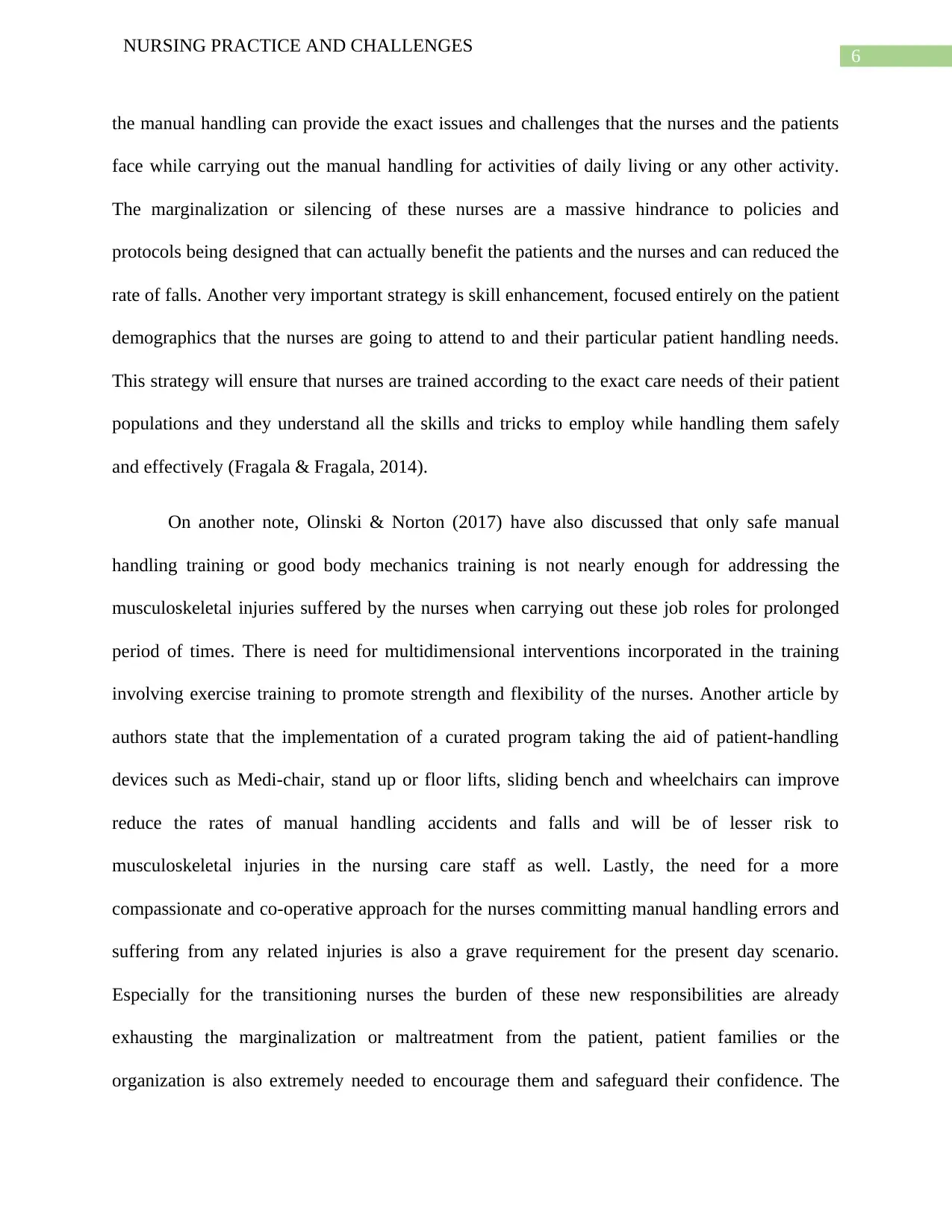
6
NURSING PRACTICE AND CHALLENGES
the manual handling can provide the exact issues and challenges that the nurses and the patients
face while carrying out the manual handling for activities of daily living or any other activity.
The marginalization or silencing of these nurses are a massive hindrance to policies and
protocols being designed that can actually benefit the patients and the nurses and can reduced the
rate of falls. Another very important strategy is skill enhancement, focused entirely on the patient
demographics that the nurses are going to attend to and their particular patient handling needs.
This strategy will ensure that nurses are trained according to the exact care needs of their patient
populations and they understand all the skills and tricks to employ while handling them safely
and effectively (Fragala & Fragala, 2014).
On another note, Olinski & Norton (2017) have also discussed that only safe manual
handling training or good body mechanics training is not nearly enough for addressing the
musculoskeletal injuries suffered by the nurses when carrying out these job roles for prolonged
period of times. There is need for multidimensional interventions incorporated in the training
involving exercise training to promote strength and flexibility of the nurses. Another article by
authors state that the implementation of a curated program taking the aid of patient-handling
devices such as Medi-chair, stand up or floor lifts, sliding bench and wheelchairs can improve
reduce the rates of manual handling accidents and falls and will be of lesser risk to
musculoskeletal injuries in the nursing care staff as well. Lastly, the need for a more
compassionate and co-operative approach for the nurses committing manual handling errors and
suffering from any related injuries is also a grave requirement for the present day scenario.
Especially for the transitioning nurses the burden of these new responsibilities are already
exhausting the marginalization or maltreatment from the patient, patient families or the
organization is also extremely needed to encourage them and safeguard their confidence. The
NURSING PRACTICE AND CHALLENGES
the manual handling can provide the exact issues and challenges that the nurses and the patients
face while carrying out the manual handling for activities of daily living or any other activity.
The marginalization or silencing of these nurses are a massive hindrance to policies and
protocols being designed that can actually benefit the patients and the nurses and can reduced the
rate of falls. Another very important strategy is skill enhancement, focused entirely on the patient
demographics that the nurses are going to attend to and their particular patient handling needs.
This strategy will ensure that nurses are trained according to the exact care needs of their patient
populations and they understand all the skills and tricks to employ while handling them safely
and effectively (Fragala & Fragala, 2014).
On another note, Olinski & Norton (2017) have also discussed that only safe manual
handling training or good body mechanics training is not nearly enough for addressing the
musculoskeletal injuries suffered by the nurses when carrying out these job roles for prolonged
period of times. There is need for multidimensional interventions incorporated in the training
involving exercise training to promote strength and flexibility of the nurses. Another article by
authors state that the implementation of a curated program taking the aid of patient-handling
devices such as Medi-chair, stand up or floor lifts, sliding bench and wheelchairs can improve
reduce the rates of manual handling accidents and falls and will be of lesser risk to
musculoskeletal injuries in the nursing care staff as well. Lastly, the need for a more
compassionate and co-operative approach for the nurses committing manual handling errors and
suffering from any related injuries is also a grave requirement for the present day scenario.
Especially for the transitioning nurses the burden of these new responsibilities are already
exhausting the marginalization or maltreatment from the patient, patient families or the
organization is also extremely needed to encourage them and safeguard their confidence. The
Paraphrase This Document
Need a fresh take? Get an instant paraphrase of this document with our AI Paraphraser
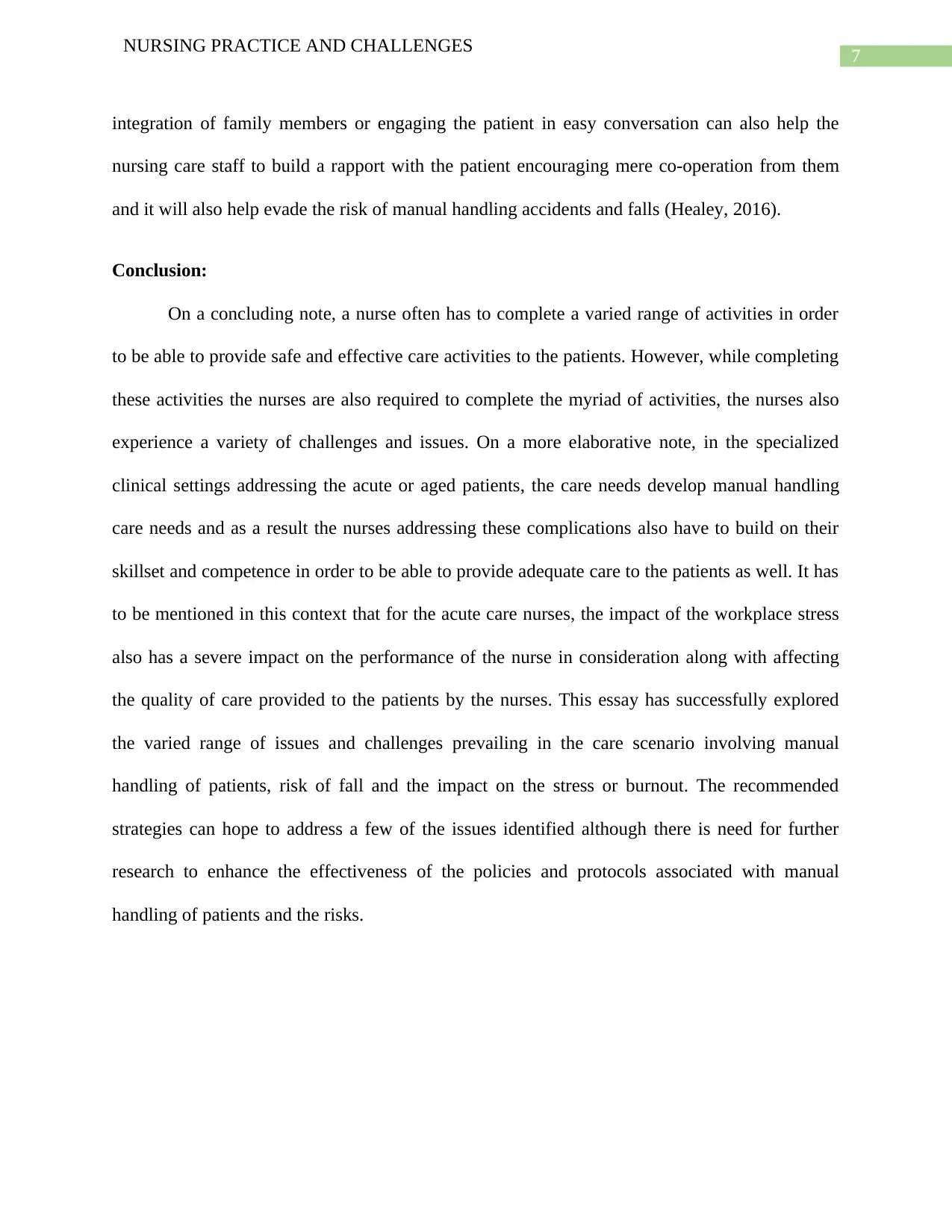
7
NURSING PRACTICE AND CHALLENGES
integration of family members or engaging the patient in easy conversation can also help the
nursing care staff to build a rapport with the patient encouraging mere co-operation from them
and it will also help evade the risk of manual handling accidents and falls (Healey, 2016).
Conclusion:
On a concluding note, a nurse often has to complete a varied range of activities in order
to be able to provide safe and effective care activities to the patients. However, while completing
these activities the nurses are also required to complete the myriad of activities, the nurses also
experience a variety of challenges and issues. On a more elaborative note, in the specialized
clinical settings addressing the acute or aged patients, the care needs develop manual handling
care needs and as a result the nurses addressing these complications also have to build on their
skillset and competence in order to be able to provide adequate care to the patients as well. It has
to be mentioned in this context that for the acute care nurses, the impact of the workplace stress
also has a severe impact on the performance of the nurse in consideration along with affecting
the quality of care provided to the patients by the nurses. This essay has successfully explored
the varied range of issues and challenges prevailing in the care scenario involving manual
handling of patients, risk of fall and the impact on the stress or burnout. The recommended
strategies can hope to address a few of the issues identified although there is need for further
research to enhance the effectiveness of the policies and protocols associated with manual
handling of patients and the risks.
NURSING PRACTICE AND CHALLENGES
integration of family members or engaging the patient in easy conversation can also help the
nursing care staff to build a rapport with the patient encouraging mere co-operation from them
and it will also help evade the risk of manual handling accidents and falls (Healey, 2016).
Conclusion:
On a concluding note, a nurse often has to complete a varied range of activities in order
to be able to provide safe and effective care activities to the patients. However, while completing
these activities the nurses are also required to complete the myriad of activities, the nurses also
experience a variety of challenges and issues. On a more elaborative note, in the specialized
clinical settings addressing the acute or aged patients, the care needs develop manual handling
care needs and as a result the nurses addressing these complications also have to build on their
skillset and competence in order to be able to provide adequate care to the patients as well. It has
to be mentioned in this context that for the acute care nurses, the impact of the workplace stress
also has a severe impact on the performance of the nurse in consideration along with affecting
the quality of care provided to the patients by the nurses. This essay has successfully explored
the varied range of issues and challenges prevailing in the care scenario involving manual
handling of patients, risk of fall and the impact on the stress or burnout. The recommended
strategies can hope to address a few of the issues identified although there is need for further
research to enhance the effectiveness of the policies and protocols associated with manual
handling of patients and the risks.
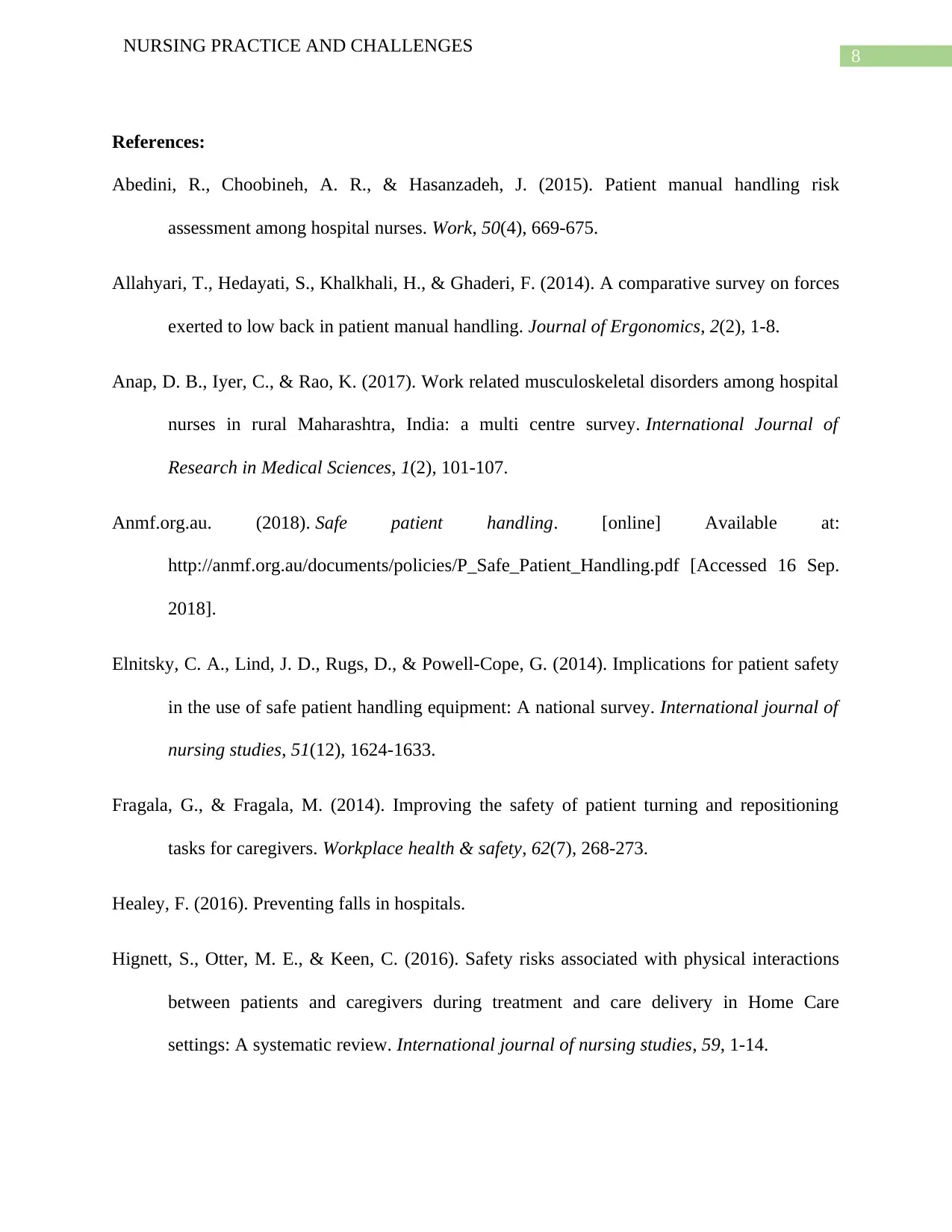
8
NURSING PRACTICE AND CHALLENGES
References:
Abedini, R., Choobineh, A. R., & Hasanzadeh, J. (2015). Patient manual handling risk
assessment among hospital nurses. Work, 50(4), 669-675.
Allahyari, T., Hedayati, S., Khalkhali, H., & Ghaderi, F. (2014). A comparative survey on forces
exerted to low back in patient manual handling. Journal of Ergonomics, 2(2), 1-8.
Anap, D. B., Iyer, C., & Rao, K. (2017). Work related musculoskeletal disorders among hospital
nurses in rural Maharashtra, India: a multi centre survey. International Journal of
Research in Medical Sciences, 1(2), 101-107.
Anmf.org.au. (2018). Safe patient handling. [online] Available at:
http://anmf.org.au/documents/policies/P_Safe_Patient_Handling.pdf [Accessed 16 Sep.
2018].
Elnitsky, C. A., Lind, J. D., Rugs, D., & Powell-Cope, G. (2014). Implications for patient safety
in the use of safe patient handling equipment: A national survey. International journal of
nursing studies, 51(12), 1624-1633.
Fragala, G., & Fragala, M. (2014). Improving the safety of patient turning and repositioning
tasks for caregivers. Workplace health & safety, 62(7), 268-273.
Healey, F. (2016). Preventing falls in hospitals.
Hignett, S., Otter, M. E., & Keen, C. (2016). Safety risks associated with physical interactions
between patients and caregivers during treatment and care delivery in Home Care
settings: A systematic review. International journal of nursing studies, 59, 1-14.
NURSING PRACTICE AND CHALLENGES
References:
Abedini, R., Choobineh, A. R., & Hasanzadeh, J. (2015). Patient manual handling risk
assessment among hospital nurses. Work, 50(4), 669-675.
Allahyari, T., Hedayati, S., Khalkhali, H., & Ghaderi, F. (2014). A comparative survey on forces
exerted to low back in patient manual handling. Journal of Ergonomics, 2(2), 1-8.
Anap, D. B., Iyer, C., & Rao, K. (2017). Work related musculoskeletal disorders among hospital
nurses in rural Maharashtra, India: a multi centre survey. International Journal of
Research in Medical Sciences, 1(2), 101-107.
Anmf.org.au. (2018). Safe patient handling. [online] Available at:
http://anmf.org.au/documents/policies/P_Safe_Patient_Handling.pdf [Accessed 16 Sep.
2018].
Elnitsky, C. A., Lind, J. D., Rugs, D., & Powell-Cope, G. (2014). Implications for patient safety
in the use of safe patient handling equipment: A national survey. International journal of
nursing studies, 51(12), 1624-1633.
Fragala, G., & Fragala, M. (2014). Improving the safety of patient turning and repositioning
tasks for caregivers. Workplace health & safety, 62(7), 268-273.
Healey, F. (2016). Preventing falls in hospitals.
Hignett, S., Otter, M. E., & Keen, C. (2016). Safety risks associated with physical interactions
between patients and caregivers during treatment and care delivery in Home Care
settings: A systematic review. International journal of nursing studies, 59, 1-14.
⊘ This is a preview!⊘
Do you want full access?
Subscribe today to unlock all pages.

Trusted by 1+ million students worldwide
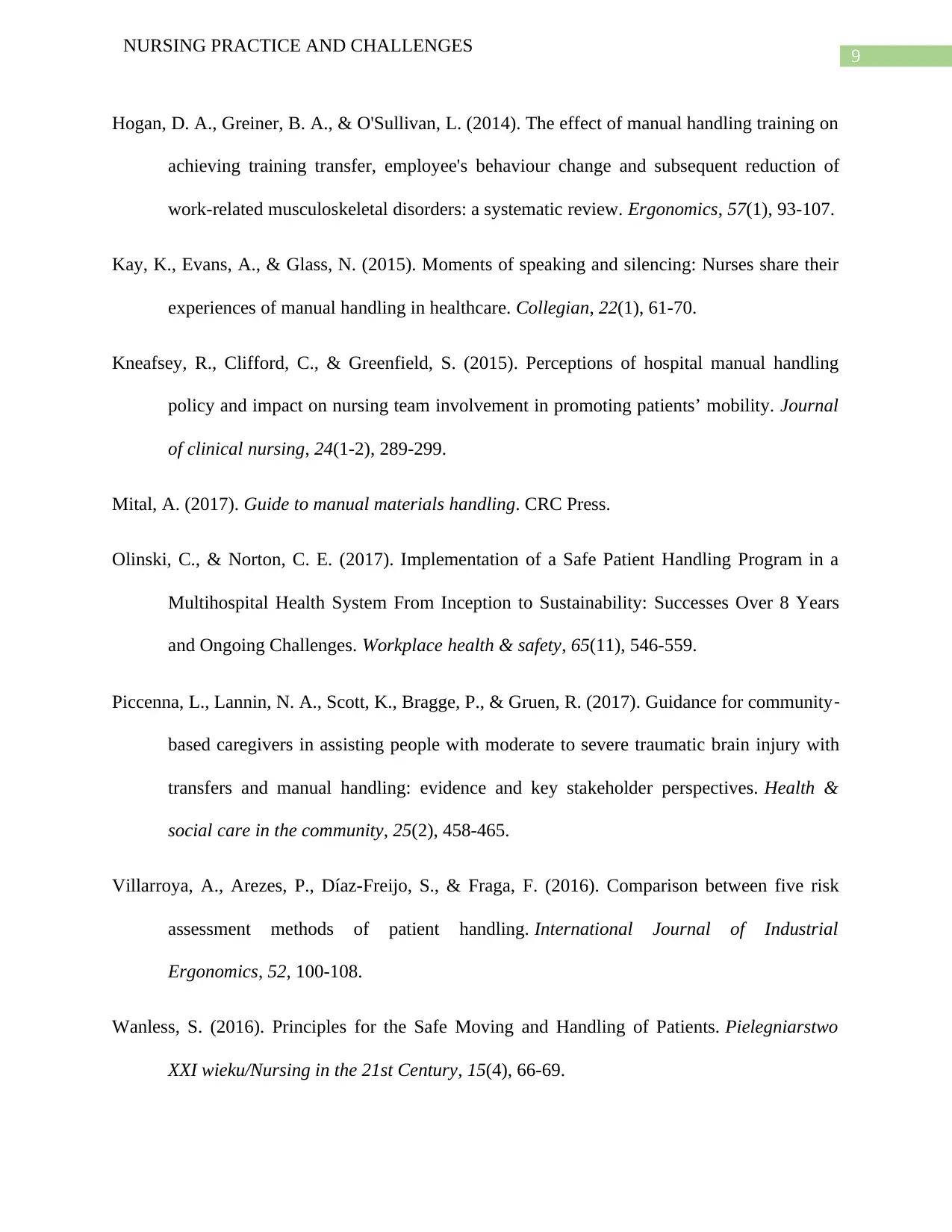
9
NURSING PRACTICE AND CHALLENGES
Hogan, D. A., Greiner, B. A., & O'Sullivan, L. (2014). The effect of manual handling training on
achieving training transfer, employee's behaviour change and subsequent reduction of
work-related musculoskeletal disorders: a systematic review. Ergonomics, 57(1), 93-107.
Kay, K., Evans, A., & Glass, N. (2015). Moments of speaking and silencing: Nurses share their
experiences of manual handling in healthcare. Collegian, 22(1), 61-70.
Kneafsey, R., Clifford, C., & Greenfield, S. (2015). Perceptions of hospital manual handling
policy and impact on nursing team involvement in promoting patients’ mobility. Journal
of clinical nursing, 24(1-2), 289-299.
Mital, A. (2017). Guide to manual materials handling. CRC Press.
Olinski, C., & Norton, C. E. (2017). Implementation of a Safe Patient Handling Program in a
Multihospital Health System From Inception to Sustainability: Successes Over 8 Years
and Ongoing Challenges. Workplace health & safety, 65(11), 546-559.
Piccenna, L., Lannin, N. A., Scott, K., Bragge, P., & Gruen, R. (2017). Guidance for community‐
based caregivers in assisting people with moderate to severe traumatic brain injury with
transfers and manual handling: evidence and key stakeholder perspectives. Health &
social care in the community, 25(2), 458-465.
Villarroya, A., Arezes, P., Díaz-Freijo, S., & Fraga, F. (2016). Comparison between five risk
assessment methods of patient handling. International Journal of Industrial
Ergonomics, 52, 100-108.
Wanless, S. (2016). Principles for the Safe Moving and Handling of Patients. Pielegniarstwo
XXI wieku/Nursing in the 21st Century, 15(4), 66-69.
NURSING PRACTICE AND CHALLENGES
Hogan, D. A., Greiner, B. A., & O'Sullivan, L. (2014). The effect of manual handling training on
achieving training transfer, employee's behaviour change and subsequent reduction of
work-related musculoskeletal disorders: a systematic review. Ergonomics, 57(1), 93-107.
Kay, K., Evans, A., & Glass, N. (2015). Moments of speaking and silencing: Nurses share their
experiences of manual handling in healthcare. Collegian, 22(1), 61-70.
Kneafsey, R., Clifford, C., & Greenfield, S. (2015). Perceptions of hospital manual handling
policy and impact on nursing team involvement in promoting patients’ mobility. Journal
of clinical nursing, 24(1-2), 289-299.
Mital, A. (2017). Guide to manual materials handling. CRC Press.
Olinski, C., & Norton, C. E. (2017). Implementation of a Safe Patient Handling Program in a
Multihospital Health System From Inception to Sustainability: Successes Over 8 Years
and Ongoing Challenges. Workplace health & safety, 65(11), 546-559.
Piccenna, L., Lannin, N. A., Scott, K., Bragge, P., & Gruen, R. (2017). Guidance for community‐
based caregivers in assisting people with moderate to severe traumatic brain injury with
transfers and manual handling: evidence and key stakeholder perspectives. Health &
social care in the community, 25(2), 458-465.
Villarroya, A., Arezes, P., Díaz-Freijo, S., & Fraga, F. (2016). Comparison between five risk
assessment methods of patient handling. International Journal of Industrial
Ergonomics, 52, 100-108.
Wanless, S. (2016). Principles for the Safe Moving and Handling of Patients. Pielegniarstwo
XXI wieku/Nursing in the 21st Century, 15(4), 66-69.
Paraphrase This Document
Need a fresh take? Get an instant paraphrase of this document with our AI Paraphraser
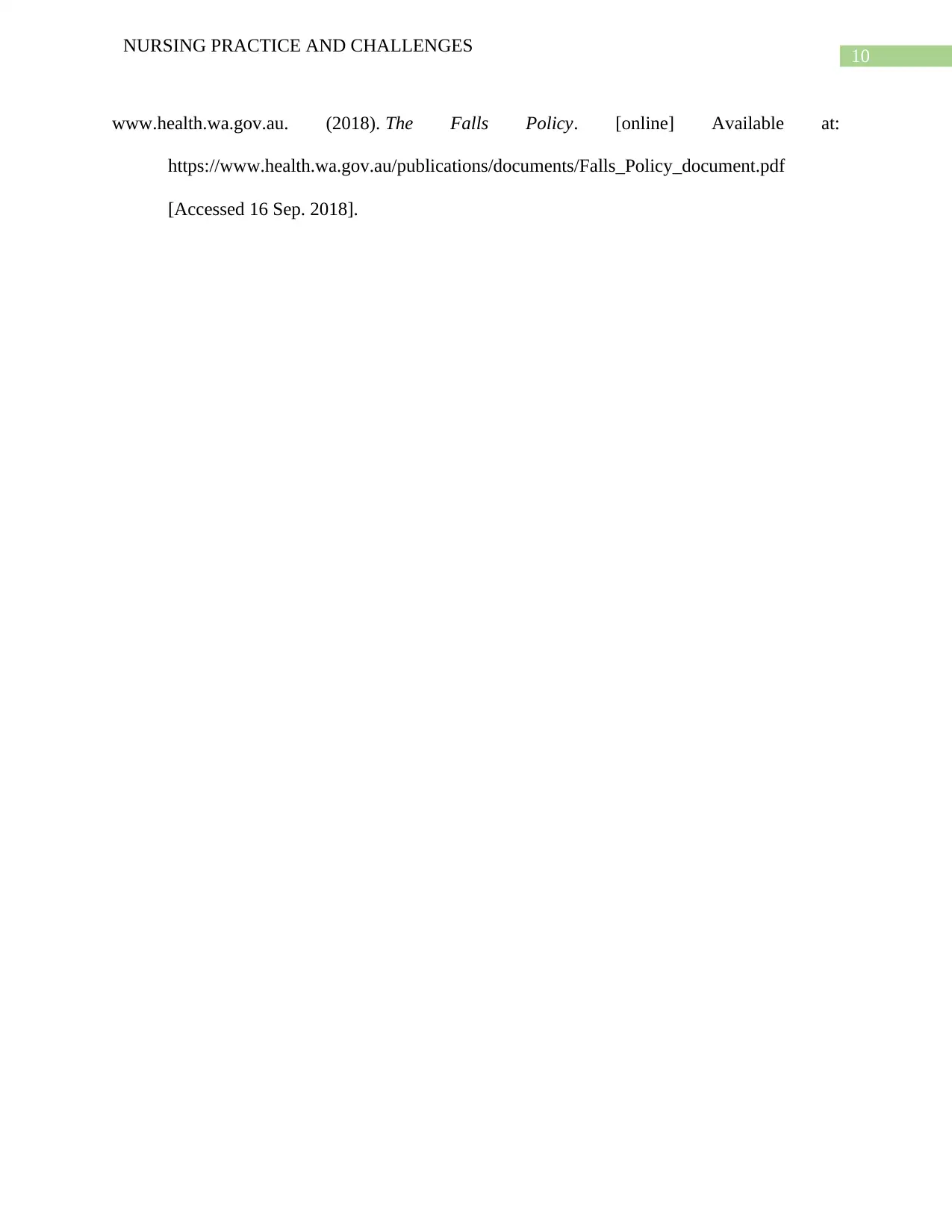
10
NURSING PRACTICE AND CHALLENGES
www.health.wa.gov.au. (2018). The Falls Policy. [online] Available at:
https://www.health.wa.gov.au/publications/documents/Falls_Policy_document.pdf
[Accessed 16 Sep. 2018].
NURSING PRACTICE AND CHALLENGES
www.health.wa.gov.au. (2018). The Falls Policy. [online] Available at:
https://www.health.wa.gov.au/publications/documents/Falls_Policy_document.pdf
[Accessed 16 Sep. 2018].
1 out of 11
Related Documents
Your All-in-One AI-Powered Toolkit for Academic Success.
+13062052269
info@desklib.com
Available 24*7 on WhatsApp / Email
![[object Object]](/_next/static/media/star-bottom.7253800d.svg)
Unlock your academic potential
Copyright © 2020–2025 A2Z Services. All Rights Reserved. Developed and managed by ZUCOL.





